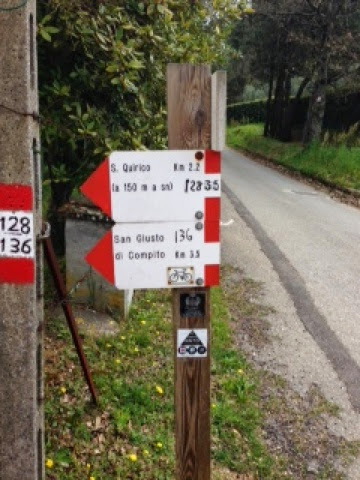Entering through one of the main gates (referred to as "porta") I immediately feel like I'm in the middle of a medieval movie set (albeit with a few thousand modern day 'extras'). Narrow lane ways shoot off in both directions as I walk up the main thoroughfare. Gift shops, pasticcerie, cheese and salami/prosciutto stores, wine stores and shops bursting with local specialties including pici pasta, saffron, honey and wild boar line the streets.
The village has obviously inspired a variety of artisans including painters, potters, leather workers and silk weavers. Beautiful ceramics displayed in a small shop front catch my eye so we head in for a look. Franco Balducci, an acclaimed potter, tends to his clay at the potter's wheel and soon transforms the lump of brown clay into a perfectly proportioned bowl and sets it on his rack to dry. I ask him how many items he produces in a day and he explained that give or take a few, he averages 70 ceramics a day. Not a bad day's work! We purchase a set of 4 tiles depicting beautiful Tuscan landscapes for the humble price of 90euro.
Http://balducciceramica.com
Handmade Tuscan leather goods including beautifully crafted boots, belts and sandals were found in via San Giovane whilst the highlight for me and thousands more every day was the World Champion gelateria, Gelateria Dondoli. Cold, creamy delights whipped up using organic, fresh produce into an array of unique Tuscan flavours beckons visitors far and wide. A lady I'd met in Lucca happened to ask me "tell me what you think of the world's best gelato when you're in San Gimignano" and without asking any questions we set about finding out what she was talking about. A quick google search directed us to the town's main piazza and it was immediately evident that we were in the right place. A queue of some 100 people filled the length of the piazza but seemed to be moving swiftly. Undeterred we joined the line up and during our wait we were fortunate to meet the founder himself, Sergio, a cheery Tuscan. He greeted us and recommended a few unique flavours like raspberry with rosemary, Vernaccia (wine) sorbet, cream with saffron and nuts, blackberry and lavender and spicy chocolate with cherries. He then told us he even visited Australia recently to work with a Guy Grossi so he was quite happy to be meeting some fellow Aussies, asking us to send our regards to Guy (since we're neighbours of course).
As far as food and wine go, Vernaccia is the most famous wine made from grapes grown in surrounding sandy soils and has DOCg status (the highest quality following strict Italian standards). The wine is light, fresh and slightly dry. Very easy to drink sitting on the terrace near the town's wine museum where you can learn how the wine is produced and enjoy tastings. Local reds, nearby Chianti and Vin Santo dessert wine are also celebrated. Saffron and locally produced honey are also specialties of the village and cheeses (pecorino), salami, prosciutto and cinghale (wild boar) are also savoured. People queued up for in excess of 40 minutes to enjoy sliced cinghale served in a crunchy bread roll from a food truck in one of the town's squares.
The winding streets, tall towers, historical wall and surrounding parklands can keep you occupied for at least a few days and I'd recommend a stay in one of the surrounding villa style hotels nearby. These provide a wonderful stay in the Tuscan countryside immersed in the movie-set scenery within easy walking distance to the village. We stayed at "la Collegiata", a restored convent from the 1500s. Our room, set in a castle-like tower (added in the 1900s) looked across the fruitful valley up to the tower filled village. Less than an hour's drive from Florence, Siena and perhaps 1.5 hours from Lucca, San Gimignano is a must for the traveller's itinerary.



































